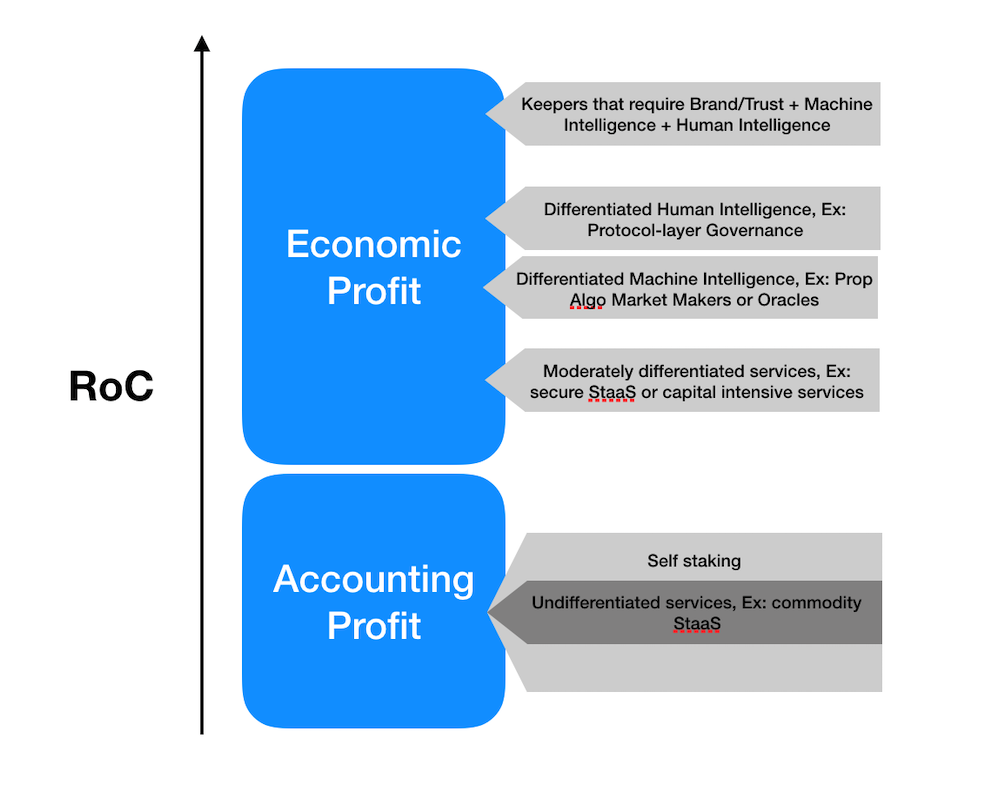
Keepers Reboot — Observations & Forward Looking Trends
Keepers — the term to generally define the utility-layer actors on P2P networks who contribute key resources and behaviors in order to achieve a cryptoeconomic-Nash-equilibrium — are a fundamental building block and source of great potential for any crypto-network. See my previous post on Keepers for an overview. Jake Brukhman calls the term “Generalized Mining”, Chris Burniske refers to Keepers as “Productive Capital”. In Bitcoin and Ethereum Keepers are referred to as “miners”, that confirm transactions and maintain network security. But Keepers can offer a much broader array of services and resources to the users of a P2P crypto-network.
Trends in Keepers
In the last year we’ve seen an explosion of interested parties looking to offer next-generation Keeper services. There is significant excitement in the space among investors and entrepreneurs for “Staking as a Service” (Jake refers to this as StaaS). Literally hundreds of startups are offering some form of Keeper service, often on multiple networks in an attempt to leverage economies of scale and lessons learned from experience. This wave of interest has led me to jam with many of these players as of late. The following are some ideas that have flowed from these conversations.
1- Differentiation will matter
Differentiated and complex Keepers services that require higher forms of intelligence should be much more attractive than commodity-Keepers services in the medium-to-long term, but timing matters a lot. Staking is a less complex service with low barriers to entry. It implies a trivial amount of computation and some reasonable security measures — but largely depends on token ownership and thus should tend towards near-perfect competition whereby economic profit is eliminated, even if accounting profit survives.
The more complex the Keeper service, the higher the barriers to entry and more durable the margin. For example, acting as a strong voice in governance on a network and being remunerated to be an expert in that community and thereby accumulating a significant pool of voting power may be a business model that is more defensible than simple staking because of the technical rigor involved. It may be that communities need to remunerate participation in governance in order to have the most talented people focused on key protocol decisions. Another example is providing differentiated oracle services. Providing reliable, credible information on-chain could require reputation and be difficult. A further example that I find particularly interesting is arbitrage traders in DeFi networks (decentralized finance). These players can differentiate themselves through the quality of their algos and potentially capture significant edge over time.
We should draw distinction between “machine services” vs “human services”. Any machine service initially requires bespoke human work to get set up, but then over time should commoditize down to minimum accounting profit. Human services (especially those that require a lot of rare, specific knowledge) should continue to capture value above economic profit over time. Currently, we are mostly in the “machine age” of cryptonetworks. However, we will migrate to more interesting human services of decentralized groups such as DAOs or cybernetic collectives over time, especially with the advent of governance.
I suspect the most attractive and durable margins will be captured by services that require both machine and human capital — think of the business model like ‘Palantir for crypto’.

It is important to note the caveat that staking is crucial to the health and security of many next generation networks and there is substantial opportunity, especially in the early days of a network. Even in the long run, some margin will remain based on the security measures that a given StaaS team offers and certainly margin for highly secure staking operations will increase in protocols where aggressive slashing conditions exists. However, staking will tend towards commoditization via one-click services in wallets and StaaS protocols like Vest. Nonetheless, early mover advantage is key to exploiting margins for machine services. The first few months of validating on a network is likely more profitable than many years in aggregate after the network has matured (think of how many BTC Satoshi earned by mining the first Bitcoin blocks).
2- Multi-Layer Keeper Networks
Novel arrangements of Keepers with greater complexity are being developed. I note that some of the most compelling next-generation networks have their Keeper-layer perform new services and contribute certain resources in concert. This is very exciting. One great example is Polkadot, a network that I am particularly interested in. In Polkadot, Validators who confirm transactions and perform message routing are subject to a police-like layer called Fisherman. Usually Fisherman are also Parachain Collators that order and prepare transactions on a parachain for inclusion on the main relay-chain. Nominators are an additional party that can provide leverage to Validators (essentially StaaS is built in at the protocol layer). These different actors must find a multi-layer Nash-equilibrium between each other. While all of this may seem complex, cryptoeconomic design that will self-adjust via the governance mechanism provides the necessary flexibility to deliver security and drive network effects, which will make for a high-performance network.
3- Mitigation of Centralization, Self-Adjusting Block Rewards
There are some inherent problems with PoS. It is natural to conclude that PoS-staking will result in a consolidation of power through inflation, as anyone doing anything other than staking on a network is getting inflated away. Further, since PoS is much more complicated than PoW, I would suppose that there are many attack vectors that have been insufficiently explored, which gives rise to super-linear returns for creative stakers willing to attack their own network for personal gain. Finally, if too many participants on a network are using their time, energy, and tokens strictly for staking, then we could see reduced innovation in other areas. Thus, we run the risk that simple PoS leads to centralization and mitigation strategies should be considered. This is why I often find myself recommending to teams to consider the following:
I would like to see more experimentation with the block reward whereby a network uses on-chain governance to parse out the block reward so that some portion goes to remunerate application developers, protocol developers, competent governance participation, oracle services and other important activities beyond transaction validation and network security.
The Polkadot community will test this model with Edgeware, a test-net with real financial incentives designed to experiment with governance models. In Edgeware, a DAO will control approximately half the block reward and will incentivize different constituents in an attempt to accelerate innovation and build a vibrant community around the values of innovation and experimentation towards thoughtful on-chain governance. I would predict that transaction validation is still robust and secure with such a model since a stronger community should lead towards more valuable network and thus considerable rewards for staking. I’m very excited about the implications of this experimental test-bed.
Another idea that I have been jamming with teams on in the DeFi ecosystem(decentralized finance networks such as decentralized exchanges or stablecoins):
I would like to see a block reward (paid in the native token) offered to bootstrap Defi liquidity providers and market-makers based on an algorithm of capital commitment and capital quality over time on the network.
I think part of the reason why we haven’t immediately seen compelling activity on many decentralized exchange networks or many other projects in the DeFi ecosystem is due to a lack of consistent liquidity. This can be remedied by treating liquidity providers like protocol-layer Keepers and directly incentivizing them through a coherent block-reward in the native token. For example, MakerDAO could offer a certain number of MKR per month for liquidity and market making services that remain on the network over time. This measure would inflate MKR but could also reduce the stability fee as a counter-weight and help the network scale by making it more attractive for the demand-side. Also, it would ensure that the market makers are appropriately represented in MKR governance over time, which has ancillary benefits.
4 — More research and modeling of Cryptoeconomic design
I am tremendously excited by the innovation being trialed in next generation crypto-networks. I’m grateful for the jam sessions with different teams in the space, reasoning through the game theory and cryptoeconomic design of new protocols. Through some of these recent jam sessions I’ve noticed that many teams are interested in more advanced modelling and testing of their cryptoeconomic models and I am actively looking for talented people to help build tools and data-driven models to test many of the theories herein. If you want to jam on some ideas, share new data, tools, best practices or findings from your own research please don’t hesitate to reach out. Further, if you want to dive deeply into cryptoeconomics research, I set up a Cryptoeconomics Lab at the Richard Ivey School of Business, which is currently seeking post-doc candidates for research positions. Apply here.
We are at the knee of the curve of tremendous growth in innovation around P2P Web3 networks. I’m very excited for what’s on the horizon.